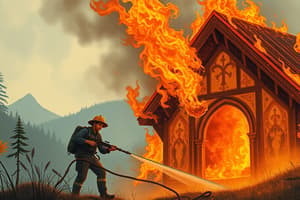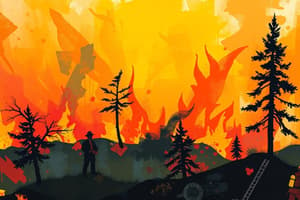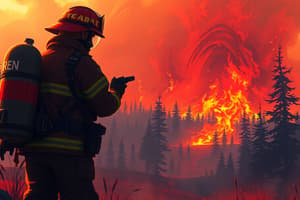Podcast
Questions and Answers
What is the focus of Module 1 Quiz?
What is the focus of Module 1 Quiz?
- Preparedness
- ICS
- Resources
- All of the above (correct)
Which of the following statements regarding physically fit firefighters is FALSE? (Select all that apply)
Which of the following statements regarding physically fit firefighters is FALSE? (Select all that apply)
- Fit workers are less likely to be injured on the fireline.
- Fit workers are allowed to serve longer hours on the fireline. (correct)
- Fit workers perform better in the heat.
- Fit workers acclimate faster at high elevations.
Place each management principle in order to match with the best description.
Place each management principle in order to match with the best description.
Unified command = An established and common set of incident objectives Span of control = Allows supervisors to track and monitor subordinates Personnel accountability = Tracks resources and assignment lists
The portion of a control line where flammable material has been removed by scraping or digging down to mineral soil is known as the ____.
The portion of a control line where flammable material has been removed by scraping or digging down to mineral soil is known as the ____.
Identify THREE facets affected by cultural differences.
Identify THREE facets affected by cultural differences.
What are THREE threats that wildland firefighter protective clothing is designed to protect against?
What are THREE threats that wildland firefighter protective clothing is designed to protect against?
Identify FOUR actions you can take to perform physically well on the fireline.
Identify FOUR actions you can take to perform physically well on the fireline.
Place the following fire behavior terms in order to match with the corresponding description.
Place the following fire behavior terms in order to match with the corresponding description.
Identify THREE steps you can take to be accountable for your personal protective equipment (PPE) and gear.
Identify THREE steps you can take to be accountable for your personal protective equipment (PPE) and gear.
Identify FOUR personal items you should consider keeping ready on a fire assignment.
Identify FOUR personal items you should consider keeping ready on a fire assignment.
Identify THREE advantages to being accountable for your gear in the fire camp.
Identify THREE advantages to being accountable for your gear in the fire camp.
Place each wildland fire part in order to match to the best description.
Place each wildland fire part in order to match to the best description.
Place each incident command system (ICS) section in order to match with its primary function.
Place each incident command system (ICS) section in order to match with its primary function.
Place the ICS positions in order to match to the appropriate locations on the organization chart.
Place the ICS positions in order to match to the appropriate locations on the organization chart.
Flashcards
High Elevation Acclimation
High Elevation Acclimation
Physically fit firefighters adjust more quickly to higher altitudes.
Unified Command
Unified Command
Establishing uniform protocols for the incident.
Span of Control
Span of Control
Supervisors effectively monitor and track the activities of their subordinates.
Fireline Definition
Fireline Definition
Signup and view all the flashcards
Cultural Aspects Affected
Cultural Aspects Affected
Signup and view all the flashcards
Protective Clothing Purpose
Protective Clothing Purpose
Signup and view all the flashcards
Creeping Fire
Creeping Fire
Signup and view all the flashcards
Running Fire
Running Fire
Signup and view all the flashcards
Backing Fire
Backing Fire
Signup and view all the flashcards
Spotting
Spotting
Signup and view all the flashcards
Torching
Torching
Signup and view all the flashcards
Crowning
Crowning
Signup and view all the flashcards
Head of a Fire
Head of a Fire
Signup and view all the flashcards
Planning Section Function
Planning Section Function
Signup and view all the flashcards
Study Notes
Module 1 Quiz
- Focuses on preparedness, the Incident Command System (ICS), and resource management.
Fitness of Firefighters
- Physically fit firefighters acclimate faster at high elevations.
- Fit workers are less likely to get injured on the fireline and perform better in heat.
- It is FALSE that fit workers are allowed to serve longer hours on the fireline.
Management Principles
- Unified command: Common incident objectives established.
- Span of control: Supervisors can track and monitor subordinates.
- Personnel accountability: Monitoring of resources and assignments.
Control Line
- The fireline is where flammable material is removed, exposing mineral soil.
Cultural Differences
- Cultural aspects affected include food, housing, dress, and religion.
Protective Clothing for Wildland Firefighters
- Designed to protect against personal injury, radiant heat, and hostile ambient temperatures.
Performing Physically on the Fireline
- Limit caffeine intake to 300 mg per day.
- Avoid alcohol and excessive red meat consumption.
- Choose whole wheat over white bread and fruits/vegetables over heavy sugars for better health.
Fire Behavior Terms
- Creeping: Burns with a low flame and spreads slowly.
- Running: Rapidly spreading fire with a defined head.
- Backing: Fire moving against the wind.
- Spotting: Sparks carried by winds from the main fire.
- Torching: Fire igniting the crown of trees.
- Crowning: Fire advancing across treetops.
Personal Protective Equipment (PPE) Accountability
- Maintain PPE in good condition and know how to use it properly.
- Routine inspections for wear and necessary repairs.
Personal Items for Fire Assignments
- Carry waterproof matches, a watch, a pocketknife, necessary eyeglasses, water, and toiletries.
- Additional items include a compass, flip flops, a flashlight, and hand sanitizer.
Advantages of Gear Accountability
- Professional appearance enhances crew morale.
- Preparedness for quick deployments.
- Reduces the risk of losing gear and minimizes environmental impact.
Parts of Wildland Fire
- Head: Greatest forward rate of spread.
- Finger: Long, narrow strip of fire.
- Perimeter: Outer boundary of the burning area.
- Rear: Area where fire usually burns against the wind.
- Flank: Parallels the main fire spread.
- Island: Unburned area within the burned zone.
ICS Section Functions
- Command: Directs overall incident management.
- Finance/Administration: Assists in cost recovery and related services.
- Logistics: Manages support needs except for aircraft.
- Operations: Achieves objectives set by the Incident Commander and incident action plan.
- Planning: Collects, evaluates, and assigns tasks through the IAP.
Studying That Suits You
Use AI to generate personalized quizzes and flashcards to suit your learning preferences.




